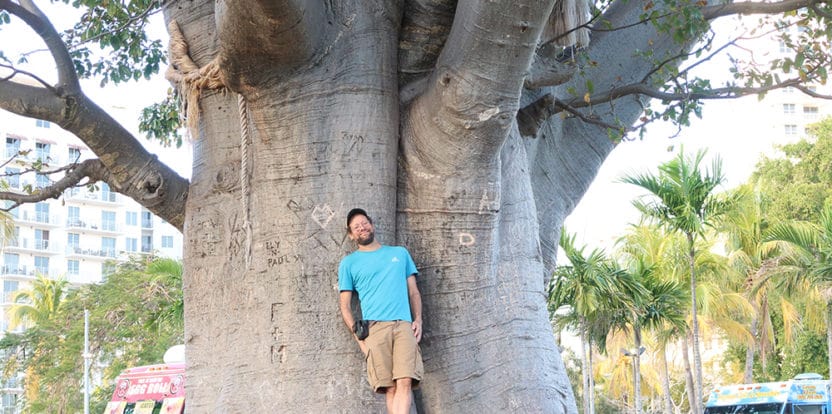African American herbalism is part of the backbone of a multitude of healing traditions in many parts of the Americas. However, it is often underappreciated, as are the rich herbal traditions of the African continent. Thankfully, a time has come where lineages such as these are being lifted up and celebrated as part of the rich tapestry of healing formed over thousands of years and thousands of miles of transition and transformation.
In many contemporary mainstream contexts, Africa is often thought of as a poor continent fraught with struggle and strife. While struggle and strife may still be true for many areas, the concept of “poor” is relative. Africa is very rich in mineral resources as well as biological and cultural diversity. Yet, like so many places, the distribution of goods to the general population is often eschewed to favor a small number of the domestic and international elite.
My Story
My own story is interwoven here as I am the son of an African American man and a Dutch woman. And my dad remarried a Jamaican woman whose community I have learned from over the years. Though I have a known lineage of healers in the African American side of my biological family, and probably further back in the European part as well, little of that knowledge has been passed down to my generation or beyond. That said, I have spent years studiously reading the literature of the African American healing traditions and learning directly from contemporary practitioners and scholars on the subject. Even still, I am continuously humbled by the scale and variety of knowledge there is to unearth and share on the subject of how Black folks have influenced the herbal traditions of the Americas! This is not really surprising when considering their influence on so many other forms of our amalgamated culture. To understand the foundation from which the practices in African American herbalism have sprung, one must first look to the continent of Africa.
Column 61 of the Ebers Medical Papyrus, New Kingdom, Eighteenth Dynasty, c. 1550 BC. The Ebers Papyrus contains roughly 900 medical prescriptions and diagnoses, written in a cursive form of hieroglyphs called hieratic. This excerpt, Column 61, outlines methods for treating the eyes, particularly “opening the sight”: to improve vision, the text suggests spreading an herbal drug mixture on the eyelids. Photo courtesy of Photo Researchers / Alamy Stock Photo.
–
Traditions and Plants of Select African Countries
Egypt, also known as Khemet, is probably one of the most well-known of the 54 countries in Africa. The herbal traditions there span thousands of years and are exemplified in the 3,500-year-old Ebers Papyrus which contains hundreds of herbal remedies.1 The traditions of this area went on to influence famous and foundational Greek and Roman healers like Dioscorides, Galen, Hippocrates, and Pliny as well as being influenced themselves by the traditions of Asia and the Middle East.
Ethiopia, also known as Abyssinia, is another East African country full of rich traditions spanning millennia. It is the original source of plants like coffee (Coffea spp.) and, along with neighboring countries, botanicals like frankincense (Boswellia sacra), khat (Catha edulis), and myrrh (Commiphora spp.).
South Africa is a wonderland of plant diversity with thousands of species that only grow there and nowhere else on Earth! The San Bushmen are one well-known group that have been studied for their herbal practices, which stem back in an unbroken chain over millennia. Many of our favorite houseplants and choice ornamentals come from this area. One major plant of commerce is rooibos (Aspalanthus linearis).
Madagascar is one of the largest islands on our planet. It is another place in the world where thousands of endemic plants live—and nowhere else. One famous medicinal is the Madagascar periwinkle (Catharanthus roseus), which is commercially used to fight cancer.2 Though vanilla (Vanilla planifolia) is native to Mexico, much of what is grown for world distribution is hand-pollinated and cultivated in Madagascar.
These are just a few examples among many of the rich botanical and cultural traditions that are contained within the continent of Africa.
The Slave Trade
West Africa is comprised of many small countries like Benin, Côte d’Ivoire, Guinea, Guinea Bissau, Liberia, Senegal, Sierra Leone, and Togo along the northwestern coast bordered by the much larger Mauritania and Nigeria, as well as several larger countries in the interior like Algeria, Mali, and Niger. From this coastal area, many of the enslaved peoples of Africa were brought to the Americas. The British, Danish, Dutch, French, and Portuguese were the major European slave traders. The Portuguese, in particular, also had a focused slave trade in the southeastern coastal areas of what is now called Angola, the Democratic Republic of Congo, and Gabon.
The scale of the slave trade was staggering. Over 11 million people in chains were brought to the Americas over the course of 350 years. Of that total, at least 1 million were brought to North America. Many ethnic groups comprised the waves of people transported in bondage to the American shores. Some cultural groups include the Akan, Bamileke, Bantu, Chamba, Ewe, Fulani, Ga, Hausa, Ibo/Igbo, Jola, Kru, Mande/Mandinka, Mbundu, Wolof, and Yoruba, among many more.3
Though many tend to think of slavery as historic, it is important to understand that millions of children in places like Côte d’Ivoire and Ghana in particular still work in close to slave-like conditions in the chocolate, or cacao (Theobroma cacao), industry. Though cacao is originally native to the Americas, most of it is now cultivated in Africa. The fact that chocolate derived from the exploitation of child labor is used in some of our most important rituals—Easter, Halloween, and Valentine’s Day—is truly appalling. One person’s pleasure is thus directly at the expense of a child’s pain. Ignorance is often bliss in regards to tough subjects like this one. However, I cannot write an article like this without helping to remove such obliviousness for the sake of those children and so many other exploited agricultural workers often of Black and brown coloration all over the world. Buying fairtrade organic chocolate is one alternative to enjoying a treat with a freer conscience about its world-wide effects.
Spiritual Traditions in the Diaspora
Cassia (Cassia senna). Illustration by Adolphus Ypey, 1813
–
Plant Material from Africa
The African continent is incredibly diverse and home to thousands of native grains, roots, fruits, vegetables, and legumes.4–7 Many foods and medicines from this cornucopia of plants have become cornerstones of international commerce. Many more likely have the potential for further research and popularization. When one of my mentors, Frank Cook, wrote his Master’s thesis, one of his findings was that African herbalism was one of the least understood and most undervalued of the various continental traditions according to his respondents from Europe and North America.8
The anthropologist Judith Carney has detailed the traditional ecological knowledge (TEK) transfer of plants from Africa to the Americas and vice versa rather thoroughly.9 Some of these findings are distilled in the following and separated into categories. Fruits and vegetables of African origin that have become staples in the Americas include black-eyed peas (Vigna unguiculata), okra (Abelmoschus esculentus), senna (Cassia spp.), sesame (Sesamum indicum), sorrel (Hibiscus sabdariffa), and watermelon (Citrullus lanatus). Some more specifically medicinal or food-as-medicine plants include aloe (Aloe spp.) and bitter melon (Momordica charantia).

